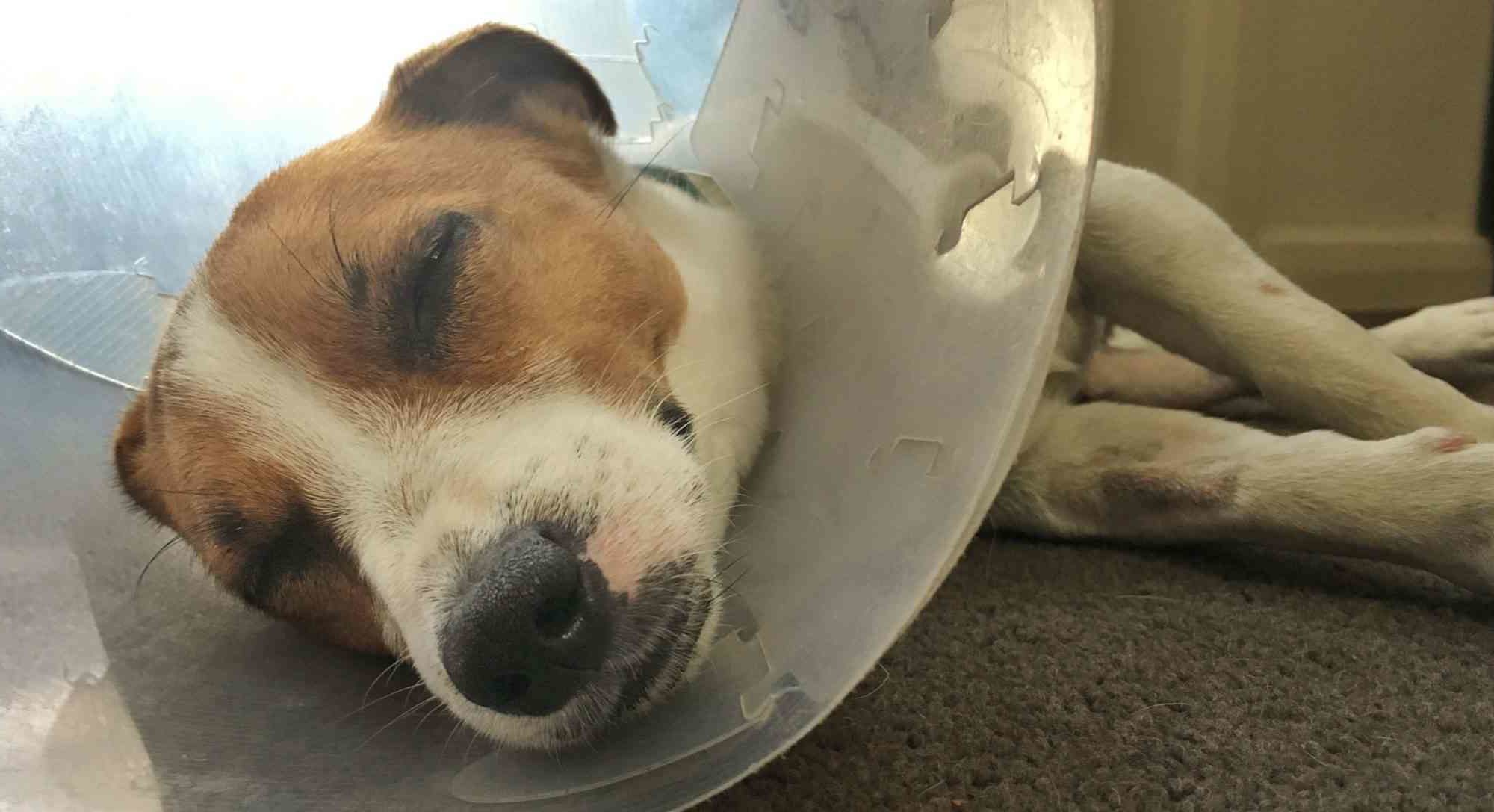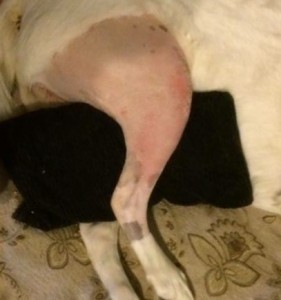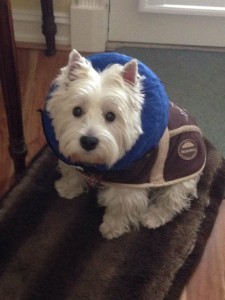Updated November 29, 2020
So your dog or cat has had an operation. Hopefully you found our guide to getting pets ready for surgery useful.
It’s just as important to think ahead and be prepared for their recovery. Simple mistakes can undo a lot of the good work.
Do Pets Need To Stay Overnight?
Nearly all dogs and cats will go home the same day of their surgery. This is certainly true for desexing and dentistry, and is mostly true even for major procedures.
Don’t worry. We won’t send them home if they need any ongoing care that you can’t provide. We know how much happier a cat or dog is with their family and will plan our surgeries so this is possible most of the time.
How Sleepy Will They Be?
By the time dogs and cats leave the vet clinic, you can hardly tell they’ve had an anaesthetic. We won’t send dogs or cats home after routine procedures unless they are fully awake and able to walk. They should be wagging their tail and happy to see you.
This can give you a false sense of confidence. Just because they can jump doesn’t mean they should!
What Time Do Dogs & Cats Go Home?
At most vet clinics, you will be told what time to expect them to go home. However, it only takes one other animal needing emergency surgery to mess up our roster! Therefore, we also advise you to call by 3pm if you haven’t heard from us. Our nurses or vets will usually call you when your pet is awake.
Routine, uncomplicated procedures like desexing, dental scale & polishes or simple lump removals can be discharged in a nurse clinic. For complex surgery, the nurses will make an appointment with a vet to talk to you about the procedure and recovery.
You will receive printed postoperative notes on what to do and the nurse or vet will explain the important points. Please ask as many questions as you can!
How To Transport Pets After Surgery
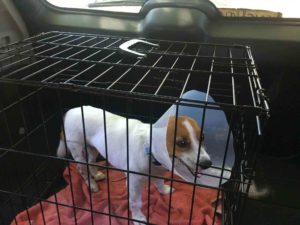
Here’s Loki on the way home after his knee surgery. Placing a crate or cat box in the car means your pet won’t be in danger of falling when you turn or stop. He’s not happy and would much rather have been held, but I was on my own.
Please either use a crate or box, a car harness or get a family member to hold them for the trip home. Don’t forget that the anaesthetic will make them less coordinated and also prone to behave unpredictably. They shouldn’t try to jump in or out of the car.
Settling At Home
Being crate trained as a puppy made Loki very easy to keep safe and happy after surgery. I placed the crate on the first day in a quiet room and let him sleep it off.
Tell the family not to expect to be able to play or make a fuss. Your pet will probably want to find a quiet, safe place to rest, and excess stimulation may cause distress.
The first night is often tough for pets, especially after major orthopaedic surgery. Despite all the pain relief, they can still experience some discomfort. The best thing is the contact of someone they love.
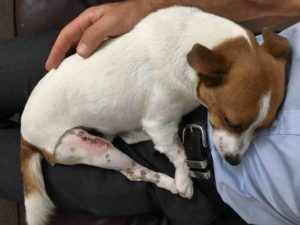
If your dog is whimpering then please by all means give them a cuddle. It’s usually all they need to quieten and settle back to sleep.
A good idea (if you can bear it!) is to bring a mattress out and set up your bed next to theirs. Just being next to a dog after surgery can provide a lot of relief. Having a dog on your bed instead can be OK, but the danger of them jumping down overnight is too much for me to take.
When Can Pets Eat & Drink?
Unless we tell you otherwise, you can offer a half-sized meal in the evening after your dog or cat goes home. Don’t give too much, and don’t be alarmed if it gets vomited up. Anaesthetics can make this happen, and it isn’t much to worry about.
It doesn’t matter if dogs take a few days to eat after surgery, but we want cats to eat by the next day at the latest. See our guide to helping cats start eating. Don’t forget that your pet has been on a drip during the day so they won’t need to drink until the day after.
Post-operative Medications
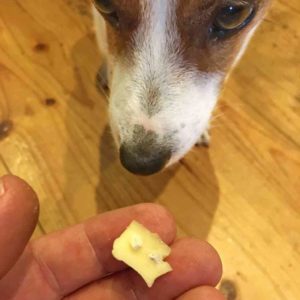
Depending on the procedure you may have tablets or drops to give at home after surgery. Please tell us if you find it hard to give medications. The picture shows the way most dog owners get the job done, and the only time most vets will tolerate the giving of cheese!
Drugs like tramadol taste terrible and are very hard to hide in food; other pets (especially cats) can’t be tricked. It’s best to give these pets their tablets by mouth. Here’s a link to our video showing how to give pills to cats.
The Cone Of Shame
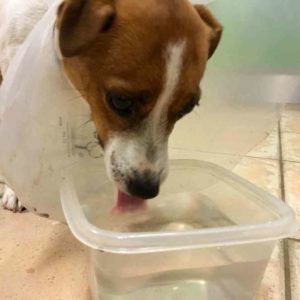
No one wants to put their dog or cat in an elizabethan collar. Sometimes you can get away with not using one. However, the odds are that if you don’t use it the wound will get damaged or infected, and the recovery will be complicated. Sometimes the wound can even be opened right up.
Read why dogs and cats just can’t leave wounds alone and the damage that licking can do.
I promise that if you leave the collar on 24 hours a day your dog and cat will get used to it and forget it’s even there. On the other hand, if you keep taking it off and putting it on they will never learn how far around furniture, doors and legs they need to steer.
Cones can make it hard to get to food and water. Here’s Loki with his water in a container that is thin and high enough for him to access while wearing the cone. The food can be put in a narrow container on top of a brick for example to get the same result.
There are also donut-shaped collars by Kong which are great for many wounds, but not all. Fergus (shown later) certainly preferred his to a regular cone.
How Much Exercise After Surgery?
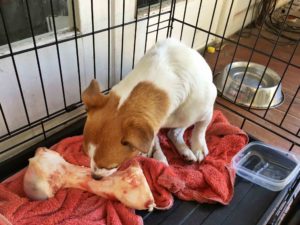
Ask your vet! Most pets can have moderate exercise, as long as it’s well-supervised. However, there are some times you will need at give strict cage rest.
A good idea is to continue to use a crate for whenever you can’t supervise your pet closely. You can make it fun like Loki’s here. Alternatively, consider setting up a room for your dog or cat to be left when unsupervised. You can add lots of amusements and soft bedding but avoid furniture that can be jumped on or off.
If allowed, exercise should be on a very short leash and only out into the street in front of your house. Avoid contact with other dogs and stop if they get too excited. It’s mainly about the mental stimulation so don’t feel you have to do anything energetic.
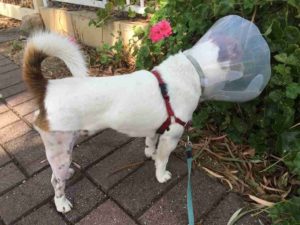
The way I see it is this. If your dog is used to regular exercise, then by excessive confinement they are likely to get stir crazy from cabin fever. Far better to give them the stimulation in a safe and controlled way than them being silly and jumpy around the house and putting the surgery at risk.
Cats should be kept inside at least until the stitches are removed. For cats it’s not just for wound care: they can very easily get dangerously stuck wearing an elizabethan collar outside.
What To Do About Constipation
Many dogs take a few days to start defaecating after anaesthetics and surgery. Don’t get stressed; they usually start going again without any problems. The exercise of a controlled walk certainly helps them to pass their motions but even in cage rest we rarely have to intervene.
If it’s been three days without a poo, please call us for advice.
Do You Need To Clean The Wound?
No. If it doesn’t look right, please come in for a check. We don’t charge a visit fee for any postoperative checks, even if you do it every day. We’d rather you were over-concerned and came in for nothing than ignore a possible problem.
When Do The Stitches Come Out?
We ask you to come back in ten days for suture removal.
Are The Stitches Dissolving?
We prefer to use skin sutures which don’t dissolve, simply because they are stronger. We also find that the wound looks better afterwards. The only times we will use dissolving sutures are for internal stitches or when removing the sutures will be very difficult. Most of the time it’s so easy we’ll have done it before you think we’ve started.
When Does The Hair Grow Back?
It takes around two months for a clipped area to look like the rest of the coat. Sorry about that, but if we don’t clip there is a high probability of infection.
Remember the most important thing: If you are worried about anything at all please ring, email or make an appointment!
Have something to add? Comments (if open) will appear within 24 hours.
By Andrew Spanner BVSc(Hons) MVetStud, a vet in Adelaide, Australia. Meet his team here. The information provided here is not intended to be used as a substitute for going to the vet. If your pet is unwell, please seek veterinary attention.

